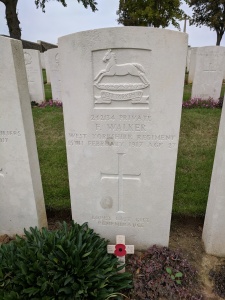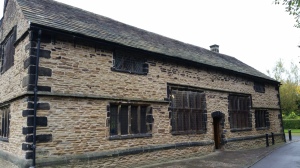Mention War Graves to anyone & they’ll most likely tell you about the ones to be found in the multitude of cemeteries in France or Flanders beautifully maintained by the Commonwealth War Graves Commission (CWGC), some may mention the fact that there are also many of these Graves equally looked after by the CWGC across the world often in quite remote places & even a single grave at times but very few will say to you there are War Graves down the road in their local cemetery or church graveyard.
But across the UK thousands of CWGC War Graves can be found in your local cemetery or churchyard as well as countless names of the fallen on family headstones with a multitude of information inscribed upon them. The War Graves are looked after by CWGC teams that cover a wide area and recently by volunteers who give reports on their local graves and carry out maintenance including clearing of foilage and light cleaning of the headstones themselves.
I moved to the Heckmondwike, West Yorkshire area over 5 years ago and I became involved in the local branch of The Royal British Legion eventually becoming it’s Branch Chairman for a few years. We got talking at one of the meetings and a fellow member mentioned that they had a relative buried in the cemetery in Heckmondwike.

So a few days later I went for a walk in the cemetery and I was surprised at the size of it at first with it’s old chapel in the centre now sadly boarded up. I soon spotted the familiar shaped Portland stone headstones used by the CWGC & walked around & read the inscribed details. There were 23 graves in total a mix of Great War & Second World War. Most of these would have died in war hospitals in the UK and then their bodies brought home to be buried by the family, others died in training/accidents or of sickness/disease, others as a result of the wounds they had received during the war but whom died afterwards within the period of entitlement to a War Grave ( 4th August 1914-31st August 1921 or 3rd September 1939- 31st December 1947). Source: CWGC.org
The condition of the graves was in general pretty good with some even having flowers placed on them recently. However one exception was a grave to 2 brothers Herbert & Wilfred Lambert. Their joint headstone was in a family plot which had sadly fallen into disrepair and was overgrown with weeds, being under a tree it was also rather discolored.
It was sad to see it in this state so I decided that I’d nip home and get some gloves, bags & a rake and try and see if I could tidy it up a little. It was hard work, it being mainly bramble type bushes that stuck to everything with it’s sharp thorns & believe me a few curses were uttered but when I’d finished it was all worth it. A lady who lived in the elderly persons flats nearby must have seen me & she came over and was surprised that she had never noticed this grave before on her daily walk. She pledged to try and look after it herself when she could & she would put some flowers or plants down.


So looking at the headstone you could see that Herbert Lambert was a Lance Corporal in the Royal Engineers & he had passed away aged just 39 on 24th February 1920. His brother Wilfred of the Kings Own Yorkshire Light Infantry had died on 12th August 1921. Upon checking the CWGC website Wilfred died aged 43 and had been Private 1257 in 12th bn KOYLI whereas Herbert had also served in KOYLI as 3176 in 1/4th bn before joining a Royal Engineers Anti Aircraft searchlight section as L/Cpl 479778.
Those that know me will tell you when I see anything like this I can’t just leave it I have to research & find out more despite usually having little time to do so!
Both Wilfred & Herbert were born in Littleborough, Lancashire, in 1878 & 1880 respectively their father originally from Bingley, West Yorkshire was a Painter & Decorator & had married Harriet Moore from Stockport. They had an elder sister Minnie & a younger sister Edith. The family had moved to the Batley area by 1891 living in Soothill before moving to 40 Blakeridge Lane, Batley by 1911. Both brothers followed their father into the Painting & Decorating trade.
Wilfred was married in 0ct/Nov/Dec 1911 to Carrie Preston , Herbert I can’t find a reliable record of him ever being married at all.
On the outbreak of war both brothers joined up. Wilfred joined the 12th (Service) bn KOYLI (Miners) .Formed by the West Yorkshire Coalowners Association in 1914 they were a Pioneer battalion. After training Wilfred embarked for EGYPT as part of 31st Division in December 1915 until being posted to the Western front in March 1916 as Divisional troops of the 31st Division. They were involved in The Battle of The Somme notably at Serre & later the Battle of the Ancre. July to November 1917 saw them transferred to Fifth Army employed on the construction of Light Railways.
It isn’t known when Wilfred was wounded but he was discharged from the Army on 16th June 1919, his pension record showing him having a disability. He received the 1915 Star, Victory & British War Medals
As for Herbert as I said earlier he joined 1/4th bn KOYLI as Private 3176. The battalion itself landed in France on 12th April 1915 before on 15th May 1915 forming 148th brigade of 49th (West Riding) Division. They took part in many engagements throughout the war including Aubers Ridge, Battle of the Somme , Third Ypres & the final battles of 1918.
Herbert himself landed in France on 20th August 1915 so would have been present in December 1915 when the division was subject to the first Phosgene gas attack. Again details of his service are slim and at some point possibly due to him being wounded and not fit for frontline service he was transferred to the Royal Engineers Anti Aircraft Searchlight Section before being discharged on 3rd March 1919 recorded again as having a disability. Again he was entitled to 15 Star, Victory & BWM.
He died on 24th February 1920 at Scarborough on the Yorkshire Coast & was buried in the family plot in Heckmondwike Cemetery. Their mother Harriet had died in 1914 & whilst their father Thomas possibly in 1925.
Another tragic story of one of Heckmondwike’s sons was that of Private 4525 Naylor Keach 3/4th bn York & Lancaster Regiment.
He was born on 11th May 1875 in Heckmondwike and when he left school Naylor followed his father into the local colliery and worked at Liversedge Coal Company as a Coke Drawer. He married Julia Ann Oram on 19th April 1897 at St. Patrick’s Roman Catholic Church in Heckmondwike & they lived in Brighton Street in 1901. Naylor & Julia had 4 children 2 sons 2 daughters by 1906 and the family then moved to Sheffield where another son and daughter were born. By 1911 they had returned the Spen Valley, living in Gasworks Street, Liversedge and Naylor was then working as a Coal Carter.
Tragically his wife Julia Ann died in June 1914 aged just 39 years leaving Naylor with 6 children to look after, the eldest being aged 16 years.
Naylor had served for 8 years in the Territorial Force with the 6th West Riding Battery of the Royal Field Artillery at Heckmondwike Drill Hall.
In the Great War he enlisted whilst he was working at White Lee Colliery as a Firer in April 1915. Whilst at Clipstone Training Camp in early March 1916 he was given 48 hours leave to visit home. Soon after he’d arrived home he was taken ill with bronchitis. He was attended by a Dr Prior but pneumonia by now had set in and he died on 25th March 1916. A sad reminder that not all casualties of the Great War happened on the battlefields.
His funeral was held on Monday March 27th with full Military Honours. His coffin was draped with the Union Flag and was accompanied by 40 men from the RFA depot in Bradford. A service was held at St. Saviour’s Church prior to his interment at Heckmondwike Cemetery. The family received letters of condolence from Naylor’s commanding officers, Captain S. Reynolds and Captain L.B. Hirst. His name is found on St. Saviour’s and St. James’s Church Memorials in Heckmondwike as well as on the town’s War Memorial in Green Park. (Source: Spen Valley Historical Society)
Not directly Great War related but of equal interest is the grave of Second World War Flight Officer Herbert J Woodward DFC the last official casualty of Fighter command in the Battle of Britain. He’d been born in Middlesex in 1916 a year before his father was to be killed at Passchendaele with 4th bn Bedfordshire Regiment. Herbert went to Blackpool Grammar School & later attended Leeds University.
He began his air training in 1937 and on completion in July 1938 he joined 64 Squadron RAF at Church Fenton near York & relinquished his earlier RAFO commission in September 1938 as he was granted a RAF short service commission.
On 31st May 1940 he destroyed an enemy Do17 over Dunkirk in his Spitfire. Then flying over Dover on 19th July his plane collided with an Me109 & suffered a damaged wing tip he just managing to return to base safely. On 5th, 8th & 12th August 1940 he destroyed several Me109s & on the 13th he shot down what would be his 2nd Do17.
He then joined 23 Squadron, a night fighter squadron, on 12th September as ‘B’ Flight Commander & as Acting Flight Lieutenant moving to flying Bristol Blenheim’s. On 1st October 1940 he was awarded the DFC for “Destroying 5 enemy aircraft & displaying Leadership & courage of a high order” (Source London Gazette Issue 34958)
However on 30th Oct 1940 he was the captain of Blenheim L6721 on a routine night patrol when they crashed in bad weather at Orchard Way Road, South Bersted near Bognor Regis. Sadly all the crew perished along with Herbert (Source: Bbm.org.uk)

There are many more stories still to be found on personal family graves as well with often an incredible amount of detail on them.
One I found in passing was to the Walker family. John Edward had died on 4th March 1901 Aged just 40 leaving his widow Emily to look after their 3 sons Fred, Harry & Arthur. As you read the headstone you soon realise the tragedy.

Emily would lose all 3 sons in the Great War. Firstly Fred Aged 28 a Private in 2/6th West Yorkshire Regiment killed on 15th February 1917 ( Family grave strangely states 1st March) and is buried at Serre Road No 1, then a few weeks later Arthur the youngest Aged just 21 would be killed on 9th April whilst a Private with 8th bn York & Lancaster Regiment & remembered on the Menin Gate & finally Harry Aged 24 Private ‘A’ Coy 10th bn Sherwood Foresters ( Notts & Derby Regiment) buried at Acheux British Cemetery. What sorrow must their poor mother of had to endure?
I pledged to visit all her sons for her on my next journey to the battlefields and I’m happy to say I fulfilled my promise, although Acheux took me a while to find down the side of a supermarche!



There are dozens more stories waiting to be found in Heckmondwike Cemetery as well as 2 more burials that I know of in the Upper Independent Chapel Graveyard but they are for another day!
My message to everyone is to go out there and explore your own local cemeteries and churchyards, find those War Graves, the personal inscriptions on family graves and tell their stories & thereby remember them. Now is an ideal time to go out there as many of us are doing alot more walking so enjoy the fresh air & breath in the history around you.













